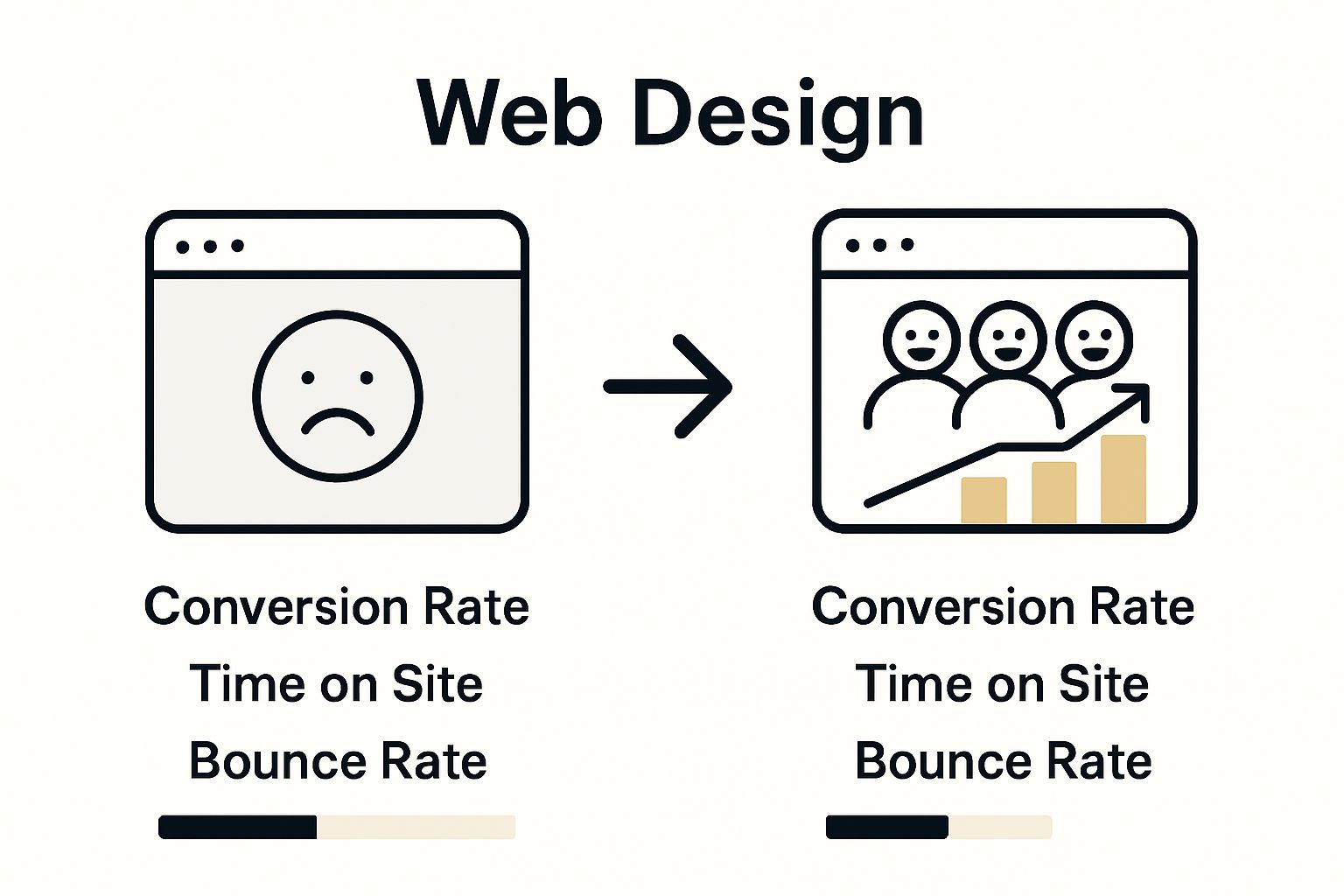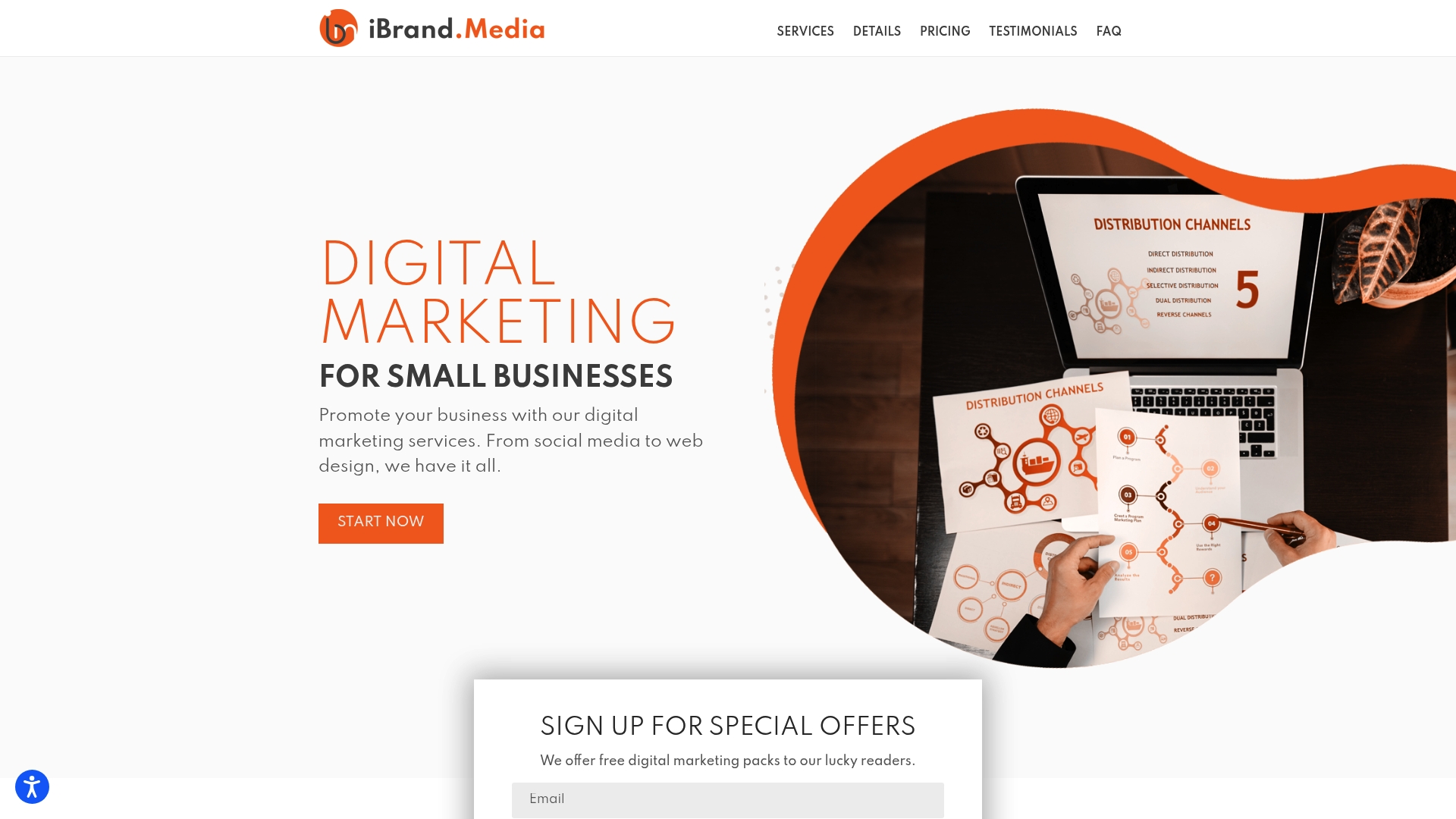Web design shapes every online experience we have, silently working behind the scenes to make websites pleasing and easy to use. Most people think it is just about making things look good with nice colors and images. Yet, studies show that users decide whether to trust a website in just 50 milliseconds, and that first impression could make or break a business. The real secret is that web design is less about flashy looks and more about building instant trust and guiding decisions faster than you can blink.
Table of Contents
- What Is Web Design and Its Core Components?
- Why Web Design Matters for Business Growth
- How Effective Web Design Improves User Experience
- Key Concepts of Web Design That Drive Success
- Real-World Examples of Web Design Benefits
Quick Summary
| Takeaway | Explanation |
|---|---|
| Web design blends aesthetics and functionality | It combines visual elements with usability to enhance user interaction and communication. |
| Professional design establishes brand credibility | A well-designed website creates trust and makes a positive first impression, crucial for customer perception. |
| Responsive design improves user experience across devices | Ensures consistent functionality on all platforms, enhancing engagement and satisfaction for diverse users. |
| Strategic web design boosts conversion rates | A seamless user experience leads to more effective pathways for visitors to complete actions, driving sales. |
| Web design differentiates businesses in the market | Innovative and attractive websites help businesses stand out, indicating customer-focus and commitment to quality. |
What is Web Design and Its Core Components?
Web design represents a comprehensive digital strategy transforming how businesses communicate and interact with their audience online. At its core, web design blends visual aesthetics, functional architecture, and strategic user experience to create compelling digital platforms that engage and convert visitors.
Visual Design Elements
Web design encompasses several crucial visual components that work together to create an impactful digital presence. Color schemes, typography, imagery, and layout play critical roles in communicating brand identity and guiding user attention. Professional designers carefully select colors that reflect brand personality, choosing palettes that evoke specific emotional responses and create visual harmony.
According to research from the Usability Government Portal, effective web design integrates aesthetic appeal with functional clarity. This means every visual element serves a strategic purpose beyond mere decoration. Professional designers understand that color, space, and visual hierarchy directly influence how users perceive and interact with digital content.
Functional Architecture
Beyond visual aesthetics, web design involves creating intuitive structural frameworks that facilitate seamless user navigation. This includes developing clear menu structures, logical information hierarchies, and responsive layouts that adapt smoothly across different devices. Read more about mobile-friendly design strategies to understand how modern websites accommodate diverse user interactions.
Key functional considerations include:
- Navigation efficiency: Ensuring users can find information quickly
- Accessibility: Creating designs that work for users with different abilities
- Performance optimization: Developing fast-loading pages with minimal friction
Effective web design transforms websites from simple digital brochures into dynamic, interactive platforms that communicate brand stories, provide valuable information, and guide users toward meaningful actions.
To help clarify the essential elements of professional web design, the following table summarizes the core visual design elements and functional architecture components discussed in the article.
| Component | Description |
|---|---|
| Color Schemes | Set of brand-appropriate colors chosen to evoke emotions and enhance visual harmony |
| Typography | Use of fonts and text styles to convey information clearly and reinforce brand identity |
| Imagery | Selection and placement of images to support messaging and engage users |
| Layout | Strategic arrangement of content for hierarchy and intuitive flow |
| Navigation Efficiency | Menus and pathways designed for fast, natural user navigation |
| Accessibility | Features ensuring usability for people with varying abilities (contrast, structure, etc.) |
| Performance Optimization | Technical measures for fast loading, smooth interactions, and reduced friction |
Why Web Design Matters for Business Growth
Web design has transformed from a simple online presence to a critical strategic asset that directly influences business performance, customer perception, and competitive positioning. In today’s digital marketplace, a well-crafted website serves as the primary interface between businesses and potential customers.
First Impressions and Brand Credibility
Website design acts as a powerful first impression generator, significantly impacting how potential customers perceive a business. Professional design communicates trustworthiness and competence. Research indicates that users form opinions about a website within 50 milliseconds, making visual appeal and intuitive navigation essential for capturing and retaining audience attention.
Discover how user experience impacts business perception to understand the intricate relationship between design quality and customer confidence.
Conversion and Business Performance
According to research from ResearchGate, strategic web design directly correlates with improved business performance. Well-designed websites can significantly enhance conversion rates by creating seamless user experiences that guide visitors toward desired actions.
Key performance benefits include:
- Enhanced user engagement: Keeping visitors on the site longer
- Improved credibility: Building trust through professional presentation
- Higher conversion potential: Streamlining paths to purchase or contact
Digital Competitive Advantage
In an era where digital presence defines market relevance, web design becomes a critical differentiator. Businesses with thoughtful, responsive, and visually appealing websites stand out from competitors who treat their online platforms as mere digital placeholders. A sophisticated web design signals that a business is modern, customer-focused, and committed to delivering exceptional digital experiences.
Ultimately, web design is not just about aesthetics but about creating strategic digital assets that drive business growth, enhance customer relationships, and establish strong market positioning.
The following table organizes key business outcomes tied to effective web design, as described throughout the article, to provide a quick reference for how design influences business performance.
| Business Outcome | How Web Design Contributes |
|---|---|
| First Impression & Credibility | Shapes users’ trust in 50 milliseconds; professional design signals trustworthiness |
| Conversion Rate Improvement | Streamlines user paths, making it easier for visitors to take action |
| Enhanced User Engagement | Keeps visitors on the site longer through seamless navigation and engaging visuals |
| Competitive Differentiation | Distinguishes business from competitors with innovative, appealing design |
| Improved Accessibility | Makes the site usable for a wider audience, boosting reputation and reach |
| Performance Optimization | Ensures fast load times and mobile-friendliness, reducing bounce rates |
How Effective Web Design Improves User Experience
User experience represents the comprehensive journey a visitor undergoes while interacting with a website, encompassing emotional responses, functional ease, and overall satisfaction. Effective web design serves as the critical framework that transforms digital interactions from potentially frustrating encounters into smooth, intuitive experiences.
Navigation and Intuitive Structure
Seamless navigation determines the quality of user interactions with digital platforms**. Strategic web design creates clear pathways that guide users effortlessly toward their desired information or action. This involves developing logical menu structures, implementing consistent layout patterns, and reducing cognitive load by presenting information hierarchically.
Learn more about website design fundamentals for local businesses to understand how thoughtful structural design impacts user engagement.
Performance and Accessibility
According to Nielsen Norman Group’s usability research, effective web design incorporates critical usability principles that enhance user satisfaction. Performance metrics like page load speed, responsive design, and cross-device compatibility play significant roles in creating positive user experiences.
Key accessibility considerations include:
- Responsive layouts: Ensuring smooth functionality across devices
- Clear typography: Enhancing readability and information comprehension
- Color contrast: Supporting users with visual limitations
Emotional Connection and Trust
Beyond technical functionality, web design influences users’ emotional perceptions and trust levels. Professional, clean designs communicate credibility and competence. Visual elements like color schemes, imagery, and whitespace contribute to creating an environment that feels welcoming and trustworthy.
By prioritizing user experience through thoughtful design, businesses transform websites from mere digital platforms into engaging, user-centric experiences that foster meaningful connections and drive positive interactions.
Key Concepts of Web Design That Drive Success
Web design transcends mere visual aesthetics, representing a sophisticated blend of strategic planning, technical expertise, and user-centered principles. Successful web design integrates multiple disciplines to create digital experiences that are not just visually appealing but functionally superior and strategically aligned with business objectives.
Strategic Visual Hierarchy
Visual hierarchy serves as the fundamental framework that guides user attention and interaction**. Professional designers strategically arrange visual elements to create natural reading patterns, emphasizing critical information and directing user focus. This involves carefully considering factors like size, color, contrast, and spatial relationships to communicate information effectively.
Explore user experience design principles to gain deeper insights into how visual elements influence digital interactions.
Responsive and Adaptive Design
According to research from Interaction Design Foundation, modern web design must prioritize flexibility across diverse digital platforms. Responsive design ensures websites function seamlessly across smartphones, tablets, laptops, and desktop computers, providing consistent user experiences regardless of screen size or device capabilities.
Critical adaptive design considerations include:
- Fluid grid layouts: Allowing content to resize proportionally
- Flexible image scaling: Maintaining visual quality across devices
- Touch-friendly interfaces: Supporting mobile and touchscreen interactions
Performance and Technical Optimization
Beyond visual elements, successful web design integrates advanced technical optimization strategies. This involves minimizing page load times, implementing efficient coding practices, and ensuring robust security protocols. Technical performance directly impacts user satisfaction, search engine rankings, and overall digital credibility.
By synthesizing aesthetic creativity with technical precision, web design transforms digital platforms into powerful communication tools that engage, inform, and convert audience interactions.
Real-World Examples of Web Design Benefits
Web design transforms theoretical potential into tangible business outcomes, demonstrating its profound impact across diverse industries. By examining concrete examples, businesses can understand how strategic digital design translates into measurable success and competitive advantage.
Local Service Business Transformation
Small businesses experience dramatic digital performance improvements through thoughtful web design. Local service providers like plumbers, contractors, and home repair specialists have witnessed significant customer engagement increases by implementing user-friendly, mobile-responsive websites. Professional design communicates credibility and makes complex service offerings more accessible.
Discover design trends for specialized business websites to understand how targeted design strategies enhance industry-specific digital presence.
E-commerce Performance Metrics
According to conversion rate optimization research, strategic web design directly correlates with improved sales performance. Online retailers who invest in intuitive navigation, clean product presentations, and streamlined checkout processes can experience conversion rate improvements ranging from 10% to 35%.
Key performance indicators include:

- Reduced bounce rates: Keeping potential customers engaged
- Increased average session duration: Demonstrating content relevance
- Higher conversion percentages: Transforming visitors into customers
Professional Service Digital Positioning
Professional service providers like medical practices, legal firms, and consulting agencies leverage web design to establish trust and expertise. A well-designed website communicates professionalism, expertise, and approachability far more effectively than traditional marketing materials.
By presenting complex information through clear, visually appealing interfaces, businesses create digital experiences that not only inform but also build genuine connections with potential clients. Web design becomes a powerful tool for storytelling, brand positioning, and customer relationship building.

Ready to Turn Your Website Into a Business Growth Engine?
If your business is ready to overcome the challenge of outdated design and missed digital opportunities, ibrand.media can help. As the article explains, first impressions and seamless user experience are critical for building trust and increasing conversions. Your customers expect fast-loading, visually appealing, and mobile-friendly websites that make navigation effortless. Let us help you meet these expectations and stay ahead of competitors who still treat their websites like digital brochures. See more ways we help brands like yours on our Uncategorized | Ibrandmedia page.

Imagine your website actually capturing and converting new leads, not just existing as an online placeholder. Take the first step now. Visit ibrand.media to explore tailored web design strategies with transparent pricing. Start your personalized plan today and set your business up for measurable success.
Frequently Asked Questions
What are the primary benefits of web design for my business?
Effective web design enhances user engagement, improves brand credibility, and boosts conversion rates. By focusing on user-friendly layouts and professional aesthetics, you can foster trust and encourage customers to take action on your site.
How can a well-designed website improve my business’s first impression?
A well-designed website creates a positive first impression by showcasing professionalism and reliability. To maximize this effect, ensure your design is visually appealing and navigates intuitively, capturing users’ attention within the first few seconds of their visit.
What role does user experience play in web design?
User experience is critical in web design as it influences how visitors interact with your site. Aim to simplify navigation, ensure fast load times, and prioritize mobile-responsive designs to make users feel comfortable and engaged throughout their visit.
How can I measure the impact of web design on my sales performance?
You can measure the impact of web design by tracking key performance metrics like bounce rates, average session duration, and conversion rates. Monitor these metrics regularly, aiming for a reduction in bounce rates by around 20% and increased conversions within a few months of implementation.
What should I consider when designing a website for my local service business?
When designing a website for your local service business, focus on clarity and mobile responsiveness to appeal to local customers. Include essential service information, contact details, and customer testimonials directly on your homepage to build trust and encourage inquiries.
How often should I update my website design?
Ideally, review your website design every 1-2 years to ensure it remains modern and effective. Regular updates can help you adapt to new trends, improve user experience, and maintain relevance in a competitive digital landscape.
Recommended
- Understanding User Experience in Web Design | Ibrandmedia
- Understanding Website Design Basics for Local Businesses | Ibrandmedia
- Understanding Mobile-Friendly Websites: Why They Matter | Ibrandmedia
- 10 Essential Website Design Tips for Small Businesses | Ibrandmedia
- Understanding SEO Best Practices for Your Business – My Blog
- Effective Website Design: Key Principles and Proven Strategies 2025

Recent Comments